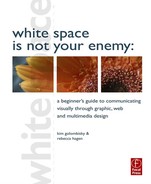Book Description
Designing a brochure or web site without an art background? Step away from the computer and read this breezy introduction to visual communications first. Written for non-designers, White Space is Not Your Enemy is a practical graphic design and layout text introducing the concepts and practices necessary for producing effective visual communications across a variety of formats, from print to Web.
This beautifully illustrated, full-color book covers the basics to help you develop your eye and produce attractive work. Topics include:
* The basics of effective design that communicates its intended message
* Pre-design planning
* 13 Layout Sins to avoid
* Basic typography
* Working with color
* Storyboarding for video, Web, and presentions
* Information graphics
* Mini Art School--all the basics in one chapter
* Outputting your work
Table of Contents
- Front Cover
- Half Title
- Title
- Copyright
- Dedication
- contents
- acknowledgments
- preface
- chapter 1
- chapter 2
- chapter 3
- chapter 4
- layout sins
- 13 amateur errors
- ♦ sin no. 1: things that blink. incessantly.
- ♦ sin no. 2: warped photos
- ♦ sin no. 3: naked photos
- ♦ sin no. 4: bulky borders & boxes
- ♦ sin no. 5: cheated margins
- ♦ sin no. 6: centering everything
- ♦ sin no. 7: 4 corners & clutter
- ♦ sin no. 8: trapped negative space
- ♦ sin no 9: busy backgrounds
- ♦ sin no. 10: tacky type emphasis: reversing, stroking, using all caps & underlining
- ♦ sin no. 11: bad bullets
- ♦ sin no. 12: widows & orphans
- ♦ sin no. 13: justified rivers
- ♦ try this
- chapter 5
- mini art school
- the elements & principles of design
- ♦ element no. 1: space
- ♦ element no. 2: line
- ♦ element no. 3: shape
- ♦ element no. 4: size
- ♦ element no. 5: pattern
- ♦ element no. 6: texture
- ♦ element no. 7: value
- ♦ principle no. 1: focal point
- ♦ principle no. 2: contrast
- ♦ principle no. 3: balance
- ♦ principle no. 4: movement
- ♦ principle no. 5: rhythm
- ♦ principle no. 6: perspective
- ♦ principle no. 7: unity
- ♦ try this
- chapter 6
- chapter 7
- chapter 8
- type
- what you don't know can hurt you
- ♦ font, typeface, font family, glyph
- ♦ font categories
- ♦ choosing & using fonts
- ♦ applying additional font styling
- ♦ typesetting for extended amounts of copy
- ♦ taking a page from newspaper design
- ♦ type: not just for reading anymore
- ♦ icing on the cake
- ♦ try this
- special section: what you need to know about logo design
- chapter 9
- color basics
- choosing & using color
- ♦ the power of color: impact, organization & emotion
- ♦ how to choose color: culture
- ♦ how to choose color: history
- ♦ how to choose color: nature
- ♦ how to choose color: color science & the color wheel
- ♦ color technology: that's not the color i chose, what happened?
- ♦ working in cmyk color space
- ♦ working in rgb space
- ♦ tips for designing with color
- ♦ color rules!
- ♦ try this
- chapter 10
- chapter 11
- chapter 12
- chapter 13
- chapter 14
- designing for the web
- starring on the small screen
- ♦ how the web works (the 5-second version)
- ♦ what to expect when working with web sites
- ♦ designing for the web
- ♦ preparing simple graphics for the web
- ♦ designing web pages & web sites
- ♦ other design considerations
- ♦ a web site isn’t always the best tool for the job
- ♦ multimedia web sites
- ♦ keep on your toes
- ♦ try this
- chapter 15
- chapter 16
- glossary
- index
